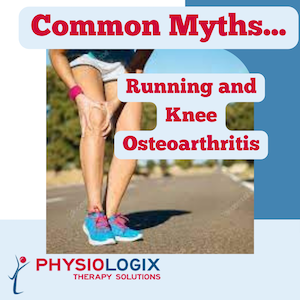KNEE OSTEOARTHRITIS AND RUNNING MYTHBUSTING
 It is a common perception that running can lead to knee osteoarthritis (OA), running can worsen knee OA or that running may increase the likelihood of needing a total knee replacement. Read on to find out all the facts and myths!
It is a common perception that running can lead to knee osteoarthritis (OA), running can worsen knee OA or that running may increase the likelihood of needing a total knee replacement. Read on to find out all the facts and myths!
What is knee osteoarthritis
Osteoarthritis is a type of arthritis that causes joint pain and impairs movement, most frequently at the hips, knees, feet and hands. The knee joint is made of a joint where the top of the lower leg, the tibia, meets the bone of the upper leg, the femur in the tibiofemoral joint. There is also a joint between your knee cap, the patella, and the thigh bone, the femur, underneath. This is known as the patella-femoral joint. A normal joint has smooth cartilage coating the ends of each bone and a good space existing between the bones, the joint space. An osteoarthritic knee has a breakdown of this cartilage, osteophytes, or bony outgrowths or spurs making the surfaces rough and uneven, and a loss of joint space. Sometimes pain can eventuate, although people with knee osteoarthritis can also be pain free.
What is the treatment for osteoarthritis: shouldn’t you stop running if you have knee osteoarthritis?
A combination of weight loss, regular exercise, and physiotherapy can help reduce stress on the joints, build strength and improve function. Other treatments can also include medication, injections and surgical intervention. However the best first treatment for osteoarthritis remains with physiotherapy.
Many people with knee osteoarthritis think they have to stop exercise, especially impact exercise, and this includes running. The research says something quite different, don’t think you have to stop running just because you have knee osteoarthritis. Yes you might need to modify things, but that’s where your physiotherapist will help advise and guide you.
 Common myths about running and osteoarthritis.
Common myths about running and osteoarthritis.
Myth 1: Regular running is associated with increased risk of developing knee OA
False
There is currently no evidence to suggest that regular recreational running will hasten the onset of knee OA. In fact, higher rates of knee OA are seen in sedentary individuals!
A slightly higher incidence of knee OA is seen in ex-elite and elite runners, but for the majority of runners, regular exercise will pose no additional risk.
Myth 2: Continuing to run with knee pain and OA will increase the risk of progression and/or surgery
False
Again, there is no evidence which backs up this claim and there is new research to suggest that regular running may actually have a protective effect.
Running may also be beneficial to the health of joint cartilage by optimising the chemical and cell components of the tissue. Regular joint movement also helps to nourish cartilage by bringing in new nutrients.
How will physiotherapy help me get back to running with knee osteoarthritis?
Sports Physiotherapists are well placed to help to guide you on your return to running journey if you are just starting out, or to keep you running if you already run regularly and ensure that you are getting the most out of it. A Physiotherapist can help to map out an ideal training schedule to manage your training loads, conduct a running biomechanical assessment to identify any abnormal mechanics, perform a musculoskeletal screening to identify any strength or flexibility deficits, provide advice surrounding footwear, prescribe a strength program to support your running, as well as manage any injuries should they arise.
Why else should you run with knee osteoarthritis or without
Running is a fantastic form of exercise for so many reasons. We have already read above why continuing to run with knee osteoarthritis is important but there are lots of other things to also consider with running.
- Inexpensive – you don’t need to pay anything to run, just step outside your door!
- Easily accessible – from the treadmill at the local gym to your neighbourhood, running is right on your doorstep
- Prevent chronic diseases – the evidence with running and its role on reduced risk with so many chronic diseases is endless, from heart issues, to blood pressure to cancer….the list is a long one all positive for running
- Weight management – lets face it, running is harder than walking, in fact it is just hard and it takes a fair bit of energy!!! And it can therefore really help with weight management.
- Longevity – research has shown runners have a 25%-40% reduced risk of premature mortality and live approximately 3 years longer than non-runners.
- Psychosocial – running has been linked with improvements for depression. And it’s a great way to catch up with like minded souls!

So in summary,
- Running is good for you!
- Running will not cause OA (but being sedentary will)
- Running is probably good for your knees
References
What is Osteoarthritis. JAMA 2022;327 (13) 1300.
Running Myth #4 Running is bad for your knees. La Trobe University SEMRC blogs
Running as a Key Lifestyle Medicine for Longevity. Prog Cardiovasc Dis. 2017 Jun-Jul;60(1):45-55.
Interested – read more on running from Physiologix
The Physiologix Running Clinic – learn what a running assessment can do for you, as well as information about our running clinic classes. Read more by clicking here.
Running injuries: what to do? Should you stop running? Will everyone benefit from a running assessment? Running injuries can occur in different areas of the leg and can vary from a muscle strain, to tendinopathy, to a bone stress fracture……and they don’t always mean you have to stop running. Read more by clicking here.
Running Injuries In Adolescents. Running is ranked as one of the top 3 activities that adolescents (10-19 year olds) partake in. There is a lot known about running related injuries in adults, but unfortunately often this research is not necessarily able to be applied to adolescents. Read more by clicking here




